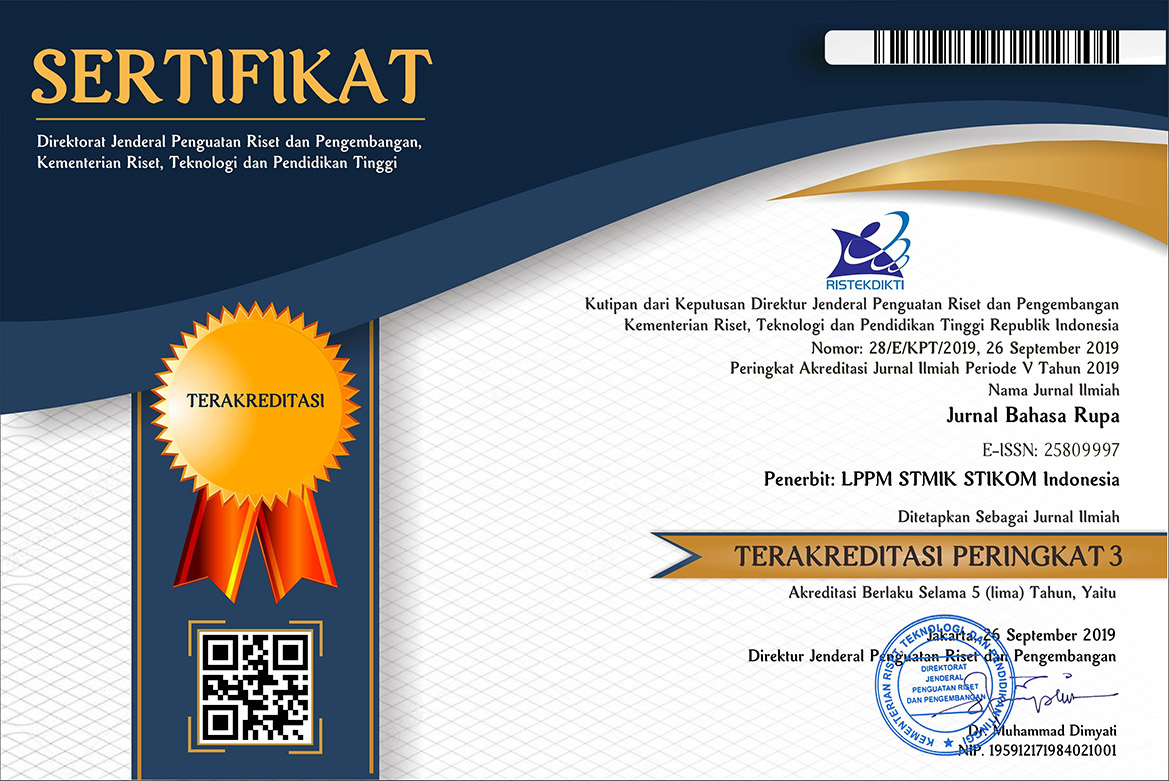E-INVITATION SEBAGAI PELUANG BISNIS ERA INDUSTRI 4.0 DI BALI
DOI:
https://doi.org/10.31598/bahasarupa.v5i1.873Keywords:
e-invitation, business opportunity, industrial era 4.0Abstract
In the 4.0 era, everything uses technology, including the dissemination of information such as wedding invitations. It can be said that in Bali the use of e-invitation is not as popular as in Southeast Sulawesi, South Sulawesi, Aceh, West Sumatra and Central Java. This study aims to describe the potential of e-invitation in the new era, especially in Bali. Qualitative descriptive method was used in this study to explore information about the importance of using e-invitation in the pandemic era and could be a business opportunity. This paper uses high concept theory and high touch and visual elements as supporting theory in data analysis method. From the research results, it is known that e-invitation has wide-open business potential in Bali. The use of e-invitation has many advantages both from an economic and environmental point of view, it's just that few people know where the e-invitation design can be made.
Downloads
References
S. Rustan, Layout 1. Jakarta: CV Nulisbuku Jendela Dunia, 2020.
Google Trends, “Google Trends membandingkan undangan digital dan kartu undangan,” 2021. https://trends.google.co.id/trends/explore?date=now 7-d&geo=ID&q=undangan digital,kartu undangan (diakses Apr 26, 2021).
A. Savitri, Bonus demografi 2030: menjawab tantangan serta peluang edukasi 4.0 dan revolusi bisnis 4.0. Semarang: Genesis, 2019.
A. B. Udayana, “Teknologi Global Dan Tumbuh Kembangnya Desain Komunikasi Visual,” in Kapita Selekta Citraleka Desain 2020: Dialektika Seni, Desain, dan Kebudayaan Pada Era Revolusi Industri 4.0, N. Jayanegara dan N. . Fajaraditya, Ed. Denpasar: STIKI Press, 2020, hal. 67.
D. H. Pink, A whole new mind: Bagaimana para pengguna otak kanan mampu menguasai masa depan. Jakarta: PT Elex Media Komputindo, 2019.
G. N. Syaifuddiin dan F. I. Pradani, “Penerapan Quick Response ( QR ) Code pada Aplikasi Electronic-Invitation (E-Invitation),” J. Ilm. MERPATI, vol. 8, no. 2, hal. 81–88, 2020.
L. Moleong, Metode Penelitian Kualitatif. Bandung: PT Remaja Rosdakarya, 2014.
Sukandarrumidi, Metode Penelitian. Yogyakarta: Gadjah Mada University Press, 2006.
T. Samara, Design Elements: A Graphic Style Manual. Massachusetts: Rockport Publisher Inc, 2007.
E. S. Rizal dan S. Maulana, Redefinisi Desain. Bandung: CmykPress, 2021.
P. Kotler dan K. L. Keller, Manajemen Pemasaran, 13 Jilid 2. Jakarta: Erlangga, 2009.
R. Devita, “Gubernur Bali Keluarkan PERGUB,Ini Tiga Bahan Plastik Yang Dilarang.” www.Balipost.com/news/2018/12/24/64588/Gubernur-Bali-Keluarkan-Pergub,Ini...html (diakses Apr 26, 2021).
Downloads
Published
How to Cite
Issue
Section
License
Copyright (c) 2021 Wina Pertiwi Putri Wardani, Anak Agung Gde Bagus Udayana

This work is licensed under a Creative Commons Attribution-NonCommercial-ShareAlike 4.0 International License.
The author's copyright in the Bahasa Rupa Journal, assigns that the publication of published articles is owned by the editorial board with the author's approval, but the rights are still with the author. The legal rules for accessing digital electronic articles are under license  Attribution-NonCommercial-ShareAlike 4.0 International (CC BY-NC-SA 4.0), which means that the Bahasa Rupa Journal has the right to store, modify, manage databases, maintain and publish articles without the author's permission, but the author as the copyright holder is still written as it is. Articles published in Bahasa Rupa Journals, both in hard and soft copy forms are available as open access, for educational, research and library purposes, and beyond that purpose, the editorial board of the Language and Language Journal is not responsible for illegal copyright infringement. This journal also applies LOCKSS and CLOKSS archiving.
Attribution-NonCommercial-ShareAlike 4.0 International (CC BY-NC-SA 4.0), which means that the Bahasa Rupa Journal has the right to store, modify, manage databases, maintain and publish articles without the author's permission, but the author as the copyright holder is still written as it is. Articles published in Bahasa Rupa Journals, both in hard and soft copy forms are available as open access, for educational, research and library purposes, and beyond that purpose, the editorial board of the Language and Language Journal is not responsible for illegal copyright infringement. This journal also applies LOCKSS and CLOKSS archiving.













.png)





